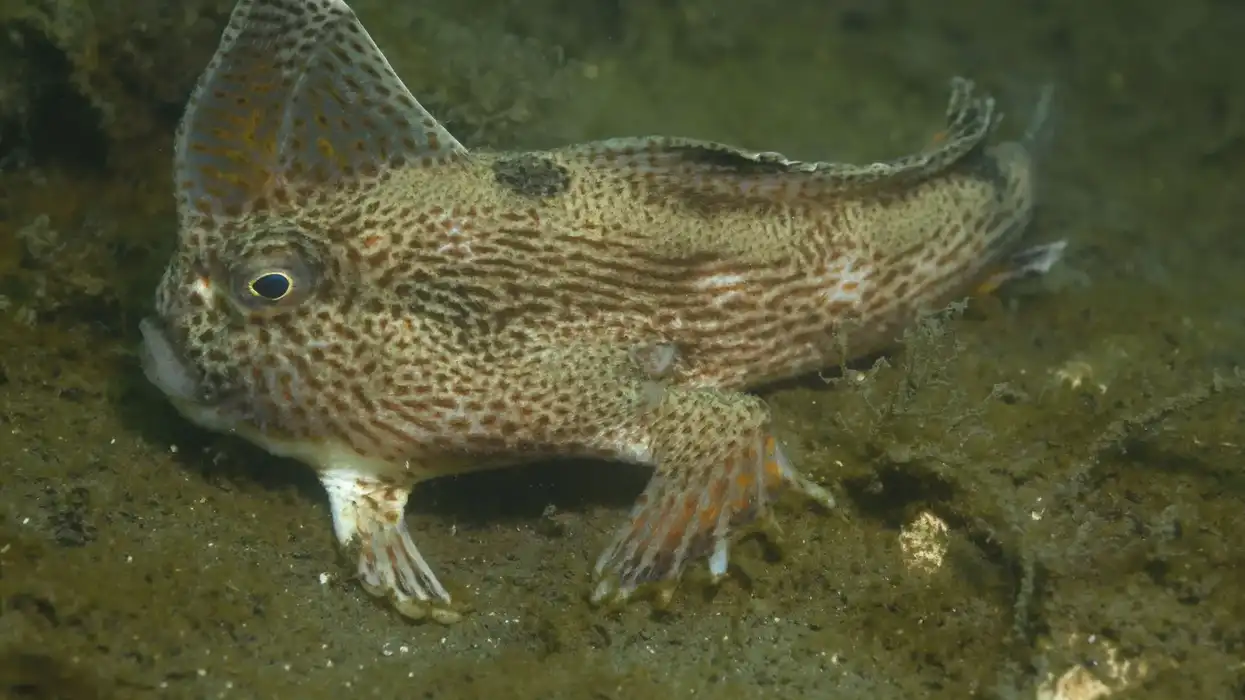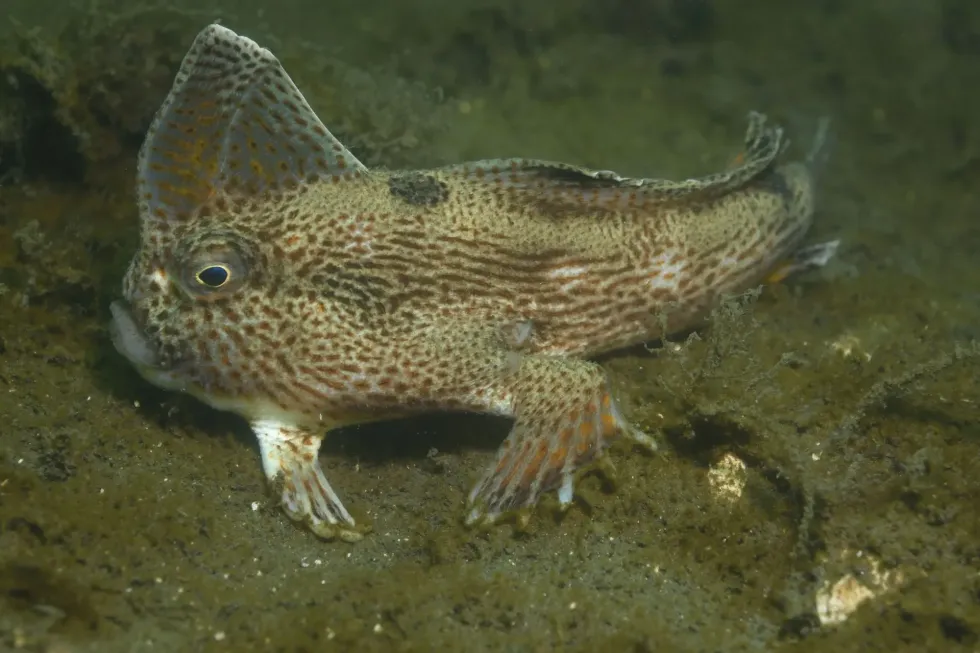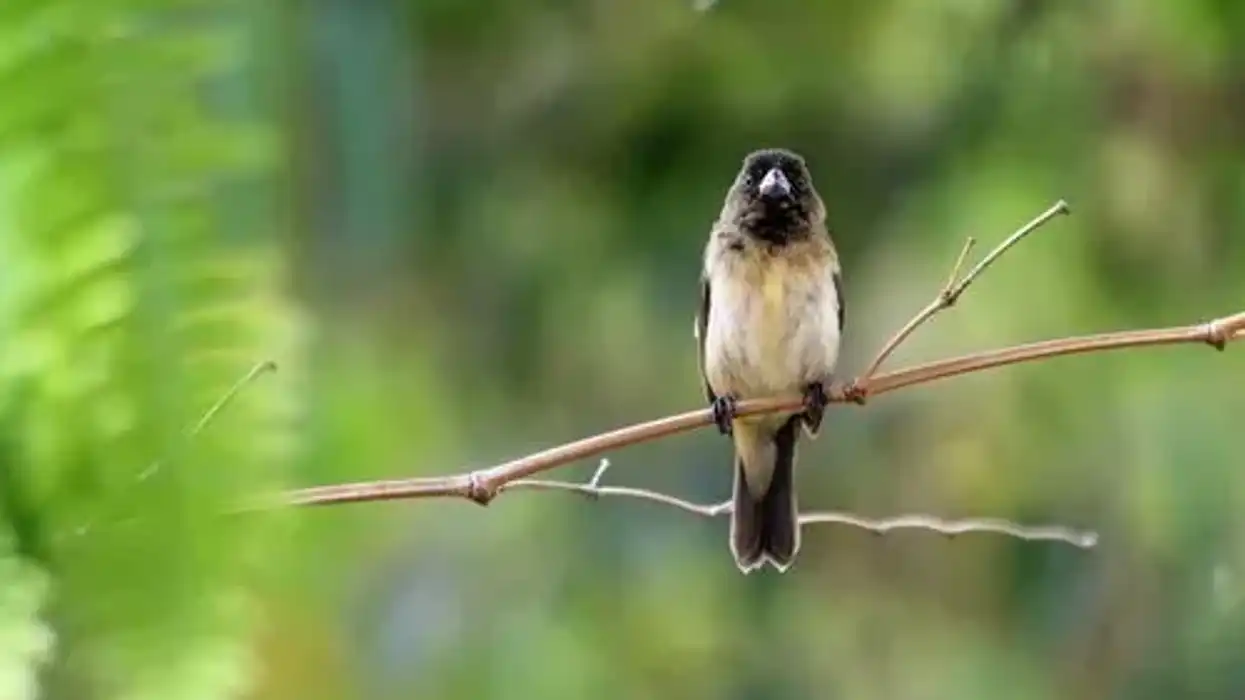The handfish is a rare family of fishes with unusual pectoral fins that look like hands. They get their name from these highly adapted hand-like pectoral fins.
These developed fins help them to walk on the seafloor. The spotted handfish is a unique type of marine fish that is endemic to Tasmania, Australia along with other species of handfish.
They have an extremely restricted range in the wild and are only found in the Derwent estuary in Hobart city. They are regarded as a Critically Endangered species across their distribution since they are rarely spotted in their original habitat.
They were one of the first marine fish that was collected in Australia and their unusual characteristics were disclosed much later. These earliest known walking fish are at present one of the most Critically Endangered marine fish that has reached near extinction.
The decreasing number was first recognized during the late '80s, before that they were fairly common and were also found in some other places in Tasmania outside Derwent.
In the late 20th century, large subpopulations of the handfish were destroyed and currently, only some fragmented groups of the previous populations survived in the Derwent estuary of Tasmania. To know more about handfishes, keep on reading these amazing facts.
For similar content check out bagre fish and Atlantic whitefish facts too.
Spotted Handfish Interesting Facts
What type of animal is a spotted handfish?
The spotted handfish is a type of walking fish belonging to the family of anglerfish.
What class of animal does a spotted handfish belong to?
The spotted handfish of Lophiiformes order and Brachionichthyidae family belong to the class Actinopterygii, the common class of all ray-finned and bony fishes.
How many spotted handfish are there in the world?
The spotted handfish is a Critically Endangered marine fish that are restricted to the Derwent estuary in the city of Hobart, Tasmania. The population of mature individuals in Derwent stands at 850 mature individuals.
A small number of handfishes have been introduced to the Australian D'Entrecasteaux channel. Out of the 3000 individuals of handfishes, the global population of the spotted handfish is estimated to be around 950 mature individuals.
The modified fins of the spotted handfish limit the dispersal abilities of the fish which results in less scattered and more localized distribution along with making them more susceptible to spotted handfish predators. These characteristics contribute to the spotted handfish's endangered status in the wild.
Consequently, they are found in isolated patches and fragmented columns. The handfish is also threatened by an unusually low rate of reproduction.
This Australian family shows all the characteristics that are required in a species to have a small population. Their population declined by more than 100 since the last estimate in 2009 when 1500-2700 mature individuals were spotted. Over the last three generations, a 90% global decline is suspected although officially evidence of only 50% decline is found.
Where does a spotted handfish live?
Spotted handfish have a very small range, they are found in a single location in Australia. The handfish species has a very patchy distribution in the Derwent Estuary of Tasmania.
In the past, the species also occurred in southern and eastern Tasmania extending from Coles Bay to the D'Entrecasteaux Channel. However, at present, they only inhabit nine sites in Derwent. Recently, two individuals were recorded outside Derwent.
One was found in Flathead Bay and the other was discovered from D'Entrecasteaux Channel, but since no valid proof has been gathered the subpopulations are discarded from the population counts. They are endemic to a very small range in Australia, and this might decrease further if the species is not properly protected.
What is a spotted handfish's habitat?
The spotted handfish is found in an estuary, showing that they prefer shallow and soft bottom areas with lower wave frequency. Often a single individual is found inhabiting a ripple or depression on the sea floor filled with shells.
They typically avoid habitats like sand flats and filamentous algae-containing areas. The juveniles move to the benthic regions as soon as the eggs hatch. Handfish are strictly benthic fish and they walk at shallow depths in the water.
A handfish can be found at depths ranging between 16-33 ft (5-10 m). Most of these benthic handfish are however spotted at 6 ft (1.82 m) depths.
Who do spotted handfish live with?
Spotted handfish are generally solitary fish, they are found alone on the sea floor and forage by themselves.
How long does a spotted handfish live?
The exact lifespan of a spotted handfish is unknown but it is expected to be more than 10 years. There are very limited specimens left in the wild and information about them is also limited.
Previously, fishes of 12-16 years of age had a body length ranging over 4 in (10 cm). However, the longevities of the handfish species appear to have decreased in the past years since their numbers began to fall.
At present, it is found that the length of this fish does not exceed 3.5 in (9 cm). This indicates that the current fish lifespan ranges between 4-10 years. The mortality of the fish is greatly affected due to habitat destruction and pollution.
There is also limited data regarding hatchling mortality. Their mortality is also hampered because of the effects of bycatch fisheries.
How do they reproduce?
The spawning season of the spotted handfish lasts from September to October. There is not much information regarding the spawning behavior of the spotted handfish. They reproduce by laying eggs.
The female releases eggs which are fertilized by sperm released by the male. A female spotted handfish can lay many eggs varying between 80-250 eggs. The laying site contains many vertical objects like seagrass, sponges, and stalked ascidians.
Handfishes lay at the base of the upright seagrass or seaweed so that the eggs remain protected. Only the females are responsible for guarding the eggs and the juveniles.
The eggs are large in size and are found on the sea bed. Handfish have a small larval period, they fry come out from the eggs after seven to eight weeks. They emerge as fully formed juveniles.
What is their conservation status?
According to the International Union for Conservation of Nature or the IUCN, spotted handfish of the Brachionichthyidae family are the first marine fish of Australia to appear under the category of Critically Endangered species in the IUCN Red List.
The species always had a small range restricted to Tasmania, however, gradually they were limited to the Derwent estuary in Hobart.
Only nine subpopulations have been spotted in Tasmania currently. Several factors contributed to the decline of Australian handfishes.
Typically spotted handfish habitat specializations and small populations have made them susceptible to disturbances in their natural habitat.
Their life is also threatened by some predators in the wild since these fishes cannot move efficiently in the water since their developed fins do not let them swim. The actual reason for the widespread decline in the '80s could not be inferred completely.
It is assumed that fishing activity in the sea caused habitat destruction and it affected their mortality because of bycatch. Apart from land clearing, mortality of these Australian species is also reduced due to pervasive pollution.
The species is now a high priority under the Australian government as well as under the Government of Tasmania. Since the species have reached near extinction, capturing them without permits is prohibited.
Several conservation measures have been introduced in Tasmania to recover the small populations of the spotted handfish. Further research and monitoring are required to increase the lifespan of Australian handfishes.
Spotted Handfish Fun Facts
What does spotted handfish look like?
The spotted handfish is a small walking fish that is found in Australia. They appear to walk on the developed pectoral fins that look like the hands of the handfish.
They have a cream, white, or brown body and are entirely covered with black, dark brown, or orange spots. The first dorsal fin is present over the head while the second one extends all the way up to the tail.
How cute are they?
They are unique and unusual-looking small fishes and have an innocent appearance which makes them look cute.
How do they communicate?
The fish communicates using chemical cues like all other fishes.
How big is a spotted handfish?
The length of a spotted handfish ranges up to 4.7 in (11.93 cm). They are three times smaller in length than the blobfish.
How fast can a spotted handfish move?
Spotted handfish move slowly in water but the speed of their movement has not been determined.
How much does a spotted handfish weigh?
The weight of a spotted handfish is unknown.
What are the male and female names of the species?
Male and the female members of this species do not have any specific name, both are called spotted handfish.
What would you call a baby spotted handfish?
A baby spotted handfish is known as fry.
What do they eat?
The spotted handfish diet is carnivorous in nature. They feed on worms, shrimp, and small shellfish in the sea.
Are they poisonous?
No, they are not poisonous.
Would they make a good pet?
Petting spotted handfish is prohibited because of their population status.
Did you know...
The scientific name of handfish comes from the Latin term 'brachium' which means 'arm' and from the Greek term 'ichthys' meaning 'fish'.
Why are they called handfish?
The pectoral fins of a handfish are developed in such a way that the fins look like hands. Therefore, they are given the name handfish. They prefer to walk rather than swim.
Why is it critically endangered?
The spotted handfish is listed as Critically Endangered in the IUCN Red List. They were the first fish of Australia to be listed as a Critically Endangered species and this status still continues.
Several conservation actions have been implemented to protect and restore the spotted handfish populations, but none have increased their numbers yet. The population of spotted handfish started declining in 1980, but the actual reason for such a drastic decline is still unknown.
The first major threat that caused the decline is believed to be habitat destruction followed by pollution, human intrusion in their environment, land clearing, and climate changes. Currently, this fish species has reached near extinction.
Here at Kidadl, we have carefully created lots of interesting family-friendly animal facts for everyone to discover! For more relatable content, check out these Amazon leaf fish facts and Alaskan blackfish facts for kids.
You can even occupy yourself at home by coloring in one of our free printable spotted handfish coloring pages.
Second image by Lincoln Wong, CSIRO









